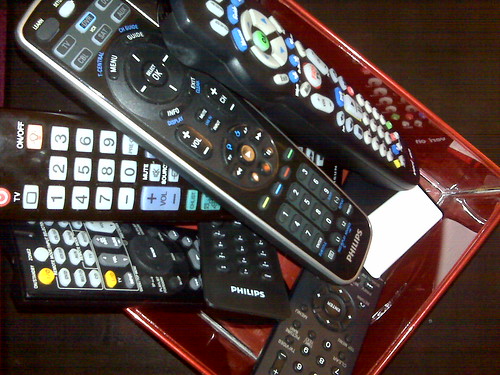
Recently I examined the ubiquitous problem of electronics: their obnoxious, blinking LEDs and displays. Our assimilation with machines has led to a subtle encroachment of electronics status updates that constantly demand our attention. But there’s yet another encroaching violator of our sanity amidst the electronics realm: remote controls.
Similar to LEDs and displays, nowhere is the plague of excessive remote controls more evident than in our home theater room. With nearly every new device comes another remote control. We need a remote control for the cable box, DVR, DVD player, Roku, multimedia receiver, multimedia PC, plasma television and streaming Internet radio receiver. I’m leaving a few devices out, but you get the idea. I have at least 50 remote controls in my house.
In fact, we have a stylish box full of remotes and, depending on which equipment I want to use, I’ll go fishing for the right one. But it’s never just one remote that’s needed; it’s always a combination of two or three. For example, a music-listening session typically requires the remotes for the Internet radio receiver and the multimedia receiver. Conversely, a movie-watching session typically requires remotes for the multimedia receiver, the plasma screen and a video source device, which might include the Roku, DVD player, or PC. Few remotes are intuitive, so every usage and combination is akin to solving a new puzzle.
Are all these remotes necessary? If you want entertainment control from the couch, then the answer is yes. Can’t you consolidate device control with a universal remote? Theoretically? Yes. Practically? No. Consolidation on a universal remote used to be possible when you had only two or three interconnected devices, like a television, cable box and DVD player. Even then, the programming of cryptic numeric codes was near-impossible, and training people how to use a universal remote was always impossible. Using multiple, dedicated remotes always worked better, even though it resulted in more clutter.
A disturbing new trend is making remotes absolutely necessary. Two such offending devices are the Roku online video streaming receiver and the Phillips Streamium Internet receiver. With these devices, the remotes are your only control. If the batteries die, you’re temporarily out of luck. If you lose the remote, then you endure the hassle and cost of acquiring new ones. This problem is especially severe for households like mine, where toddlers are on a never-ending mission to seize and hide remotes. They often leave them outside in the sandbox, or secretly take them into the bathtub.
Similar to the problem of LEDS and status displays, this version of remote control hell stems from design and engineering flaws. On an individual level, electronics manufacturers most often fail to produce simple, dedicated remotes that work well with even a single device. This most often comes on top of devices that start out with a poor interface, or, increasingly, no interface at all.
In the commons, the entire electronics industry has failed to recognize that all customers assimilate with many different electronic devices from many different manufactures. They fail to recognize that every consumer creates his own modular realm of utility and entertainment. One bad remote is bad. But many remotes create complexity and dissatisfaction of exponential proportion. It would be great if manufacturers could band together to solve this problem.
The encroachment of excessive and poorly designed remote controls has been subtle yet ubiquitous. That’s probably why few people speak up. But the problem has gotten bad enough. It’s time to speak up and fight back!
(The above also ran in MediaPost.)

![Reblog this post [with Zemanta]](http://img.zemanta.com/reblog_c.png?x-id=41338673-5c30-45d3-9348-29d19a753ec3)
I have a grand total of three remote controls – four, if you count my iPhone with its various remote apps (I have a Mac in the living room for streaming media). One is for the home theater system, one is for the DVD player, and the last is for the digital tv box (not a cable box, we actually gave up on cable). I don't have a remote for the tv because I lost it – but it's not necessary, anyway. I never leaves channel 3, and the volume is controlled via the home theater system.
I can see where you're coming from, though. In an ideal world, every manufacturer would adhere to an industry spec that allowed any device to be controlled by a master remote with no hassle. Honestly, I don't see any downside to that. It's not like anyone goes to buy a DVD player and thinks, “well gosh, I'd better by the Sony DVD player because my tv is a Sony!” There's very little brand loyalty with stuff like this, as far as I know <shrug>
Thanks for your feedback. People pointed me to the Logitech Harmony as an
easy-to-use super-charged universal remote control. It looks pretty cool,
but not a material cost at US$250, and still doesn't solve the core issue of
bad design and engineering, among specific manufacturers and collectively.
Have you tried a Harmony remote? Even the lower priced models would work for you. A smart guy like you should be able to set one up. It is relatively easy and will free that stylish box up to be used for collecting something else.
Hi Derek,
Thanks…Many have recommended the Harmony since I posted. It seems like a
great product, but sure wish we didn't need it to begin with. I definitely
need less clutter.
Have you tried a Harmony remote? Even the lower priced models would work for you. A smart guy like you should be able to set one up. It is relatively easy and will free that stylish box up to be used for collecting something else.
Hi Derek,
Thanks…Many have recommended the Harmony since I posted. It seems like a
great product, but sure wish we didn't need it to begin with. I definitely
need less clutter.